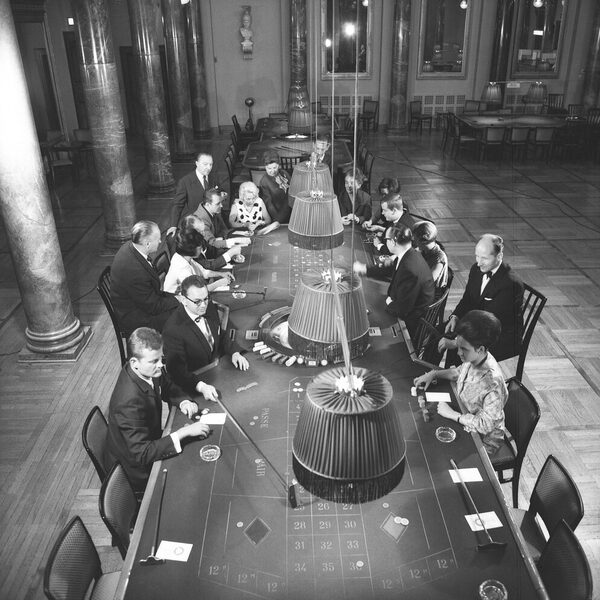Casino
In the mid-18th century, there were few opportunities for Wiesbaden's spa guests to pass the time. There was no social house and no casino; foreigners only had the opportunity to play billiards. A request by the innkeeper of the Schwarzer Bär to set up twelve tables for playing cards, dice and a checkers was turned down in 1751.
It was not until 31.01.1771 that Prince Karl Wilhelm zu Nassau-Usingen granted Joseph Negrell the license to operate the so-called Hasard game. The leaseholder was only allowed to set up his gaming table in the better hotels, such as the Schützenhof and the Einhorn, and later also in the Café Stadt Frankfurt and the Hotel Adler. The Schutzjuden Liebmann Salomon was permitted to set up a gambling establishment for Jewish bathers. Initially, the Pharaoh and Basette games were in vogue, followed by roulette in Wiesbaden in 1782, Trente et quarante and, from 1809, Biribi, an Italian card game of chance. The lease initially amounted to 200 fl., but by 1810 it had risen tenfold. A distinction was made between the small and the large casino. For the latter, the leaseholder Johann Michael Hyenlein paid 715 fl. per year in 1800.
A new era began with the construction of the Kurhaus: in the gaming rooms there, you could indulge your passion at the Pharaoh's Bank, at roulette or at Rouge et Noir. The gambling was financed by the issue of 100 shares. In 1810, the Kurhaus was leased with the casino monopoly to the royal Bavarian Major Freiherr von Fechenbach and again to Hyenlein for twelve years, but the Hasardspiel was later separated from the Kurhaus operations. In 1821, Matthias Feuser from Koblenz was awarded the contract for a new lease, which amounted to 11,000 fl. per year.
A new era in the history of the casino was heralded by the ban on all casinos in France on December 31, 1837. This was the signal for German casinos to finally achieve international significance. On July 30, 1832, the highest bid for the Kurhaus lease was subsequently outbid by the Frenchman Anton Chabert from Strasbourg by 690 fl. The lease for the Kursäle and the Hasardspiele in Bad Ems, Wiesbaden, Bad Schwalbach and Schlangenbad amounted to 31,000 fl. per year. In November 1834, Chabert suggested using the large hall as a gambling hall due to the increasing demand for the Hasardspiel. This request was granted and the playing time was extended to October. Most of the gamblers came from Mainz and Frankfurt; the people of Wiesbaden and all residents of the Duchy of Nassau were prohibited from taking part in gambling.
The consequences of gambling addiction had already been lamented since 1832 and a ban on gambling was demanded. In 1845, the government abolished the casinos in Bad Schwalbach and Schlangenbad, but not in Wiesbaden. Probably because of this uncertainty, Chabert transferred the lease to Anton Guntz from Hagenau in Alsace. The contract initially ran until 1855 and was then extended until 1870. The people of Wiesbaden themselves wanted the Hasardspiel to continue in winter in order to establish the winter cure more firmly. However, on January 8, 1849, the revolutionary National Assembly passed a law to abolish the casinos. As financial compensation, the government allowed the city to levy a spa tax, among other things. Due to the expected deficit, feverish efforts were made to find a solution to keep the casino open after all, and it was finally decided to allow gambling in closed societies. The casino tenants Guntz and Simon then opened the game in July 1849 in the Kurhaus in reserved rooms supervised by the police.
With the end of the 1848 revolution, the restrictions on gambling also came to an end in 1850 and operations even increased. In October 1856, the previous casino tenants ceded their rights to the Berlé banking house for over one million guilders, which founded a public limited company to operate the spa establishments in Wiesbaden and Ems. Until 1865, the annual net profit averaged 565,126 fl.; gaming operations were extended until December. Due to the importance of the casino for Wiesbaden, Prussia granted the public limited company and the city a reprieve of six years in 1866. The casino was closed on December 30, 1872.
As early as the 1920s, Wiesbaden once again tried to obtain a permit for gambling, but without success. It was not until Lord Mayor Georg Krücke received a permit from the American military government. On 29.10.1948, the casino was opened in the foyer of the State Theater. The casino license was acquired by Carol Nachman and Neuland KG. In November 1955, the casino moved into the north wing of the new Kurhaus, which had previously been occupied by US troops. About a year later, the Kleine Spiel was opened. Neuland KG remained the casino licensee until 1990 despite several bidding competitions. In 1982, the Kleine Spiel was opened in the renovated east wing of the fountain colonnade. On March 1, 1986, the residence ban was lifted; from then on, the Big Game was also open to Wiesbaden residents. On January 1, 1991, the concession was transferred to Spielbank Wiesbaden GmbH & Co, which is backed by Hamburg-based Jahr & Achterfeld Beteiligungs-KG and two well-known Munich restaurateurs, among others.
Literature
Niedenthal, Erhard: The game in Wiesbaden. History of the casino, Wiesbaden 1997.

